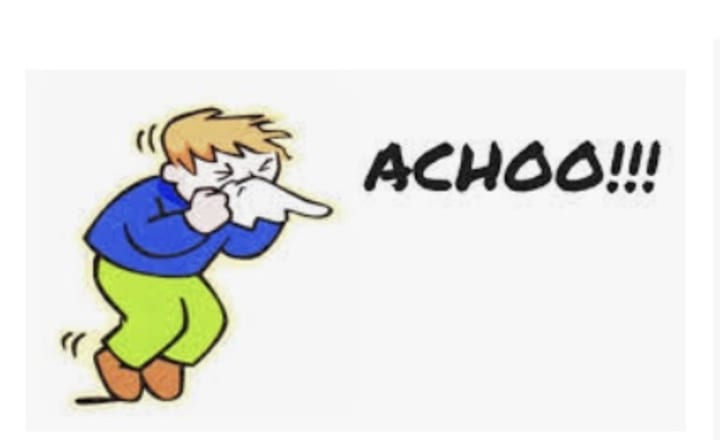“ACHOO” What it Stands For and Why We Sneeze
Important During the Pandemic

Achoo... Achoo. “Again? Really?”I think to myself. Ugh why do we randomly sneeze? It seems to be a rather simple concept that everyone just accepts because it’s just a sneeze but there’s actually a lot behind exactly why we sneeze. Just like breathing is an involuntary action, sneezing is also an involuntary reaction yet often unexpected.

The obvious most commmon causes of a sneeze are allergies and/or sickness, sudden prolonged exposure to cold air, exposure to light which I will explain that theory later, and the heavy use of nasal spray but the actual action of a sneeze is a lot deeper than just a simple reaction to an stimulant and/or irritant.
The basic stripped down action of a sneeze is an involuntary release of air from our nose in an effort to dislodge the irritant in our nose whether it be dust, dirt or simple allergens. However, the actual sneeze itself has an interesting science behind it. I’ll go over the exposure to light theory first because it’s most interesting and explains the origin of the word “ACHOO.”
The theory and science behind sneezing when exposed to light (also known as phoetic sneeze reflex which is often inherited) is the most interesting kind of sneeze because it explains where the term “ACHOO” comes from. Studies in China studied phoetic sneeze reflex (sneezing when exposed to light) which is also called Autosomal dominant Compulsive Helio Opthalmic Outbursts (Achoo syndrome.) It causes múltiple uncontrollable involuntary reflexive sneezing when you’re exposed to light. I know when I have felt a sneeze coming on I always looked at a light knowing it would make me sneeze. I never knew there was an actual scientific reason for it. It’s quite fascinating when you think about the idea that the mere fact of looking at light can induce a sneeze. It inherently occurs in 1 out of 4 people regularly and more commonly in men according to the study done in 2019 in China, which included 3900 participants.

So now for the actual science behind a “simple” sneeze also known as the sneeze reflex. Our bodies are complex machines that accomplish an innumerable amount insane tasks everyday and sneezing while seeming menial and trivial, actually has a rather complex amount of steps for out bodies to actually complete the action of a sneeze. The sneeze reflex starts with an irritation of sorts to the nasal lining and cilia nerves which are the hairs in our nose that at the end are attached to nerves. These nerve receptors then send warning signals to the sensory trigeminal nerves to then what’s known as the sneezing center in the lateral medulla in the spinal cord according to Dilraj Kalsi, MD. Once sent to the spinal cord two different nerve signals are triggered and alerted. Kalsi stated that one transmission is sent to the pharyngeal, laryngeal and respiratory muscles thus finally causing the sneeze at that point. The second part of the transmission is the nerve sensation sent via the parasympathetic nerves which causes the actual nasal secretion and the formation of tears. Just before you sneeze, however, pressure builds up in your chest as your chest muscles compress and constrict your lungs thus creating the reaction of your vocal cords abruptly closing. When the vocal cords rapidly reopen again, air is navigated up your respiratory tract and through your nose at a high rate of speed. What occurs next is what we are all commonly familiar with; your eyes then shut and your diaphragm moves in an upward position while simultaneously your chest muscles contract releasing air from your lungs and yes a sneeze finally occurs. Fascinating that a “simple” sneeze has such a complex series of steps and events occurring in the body in order to complete the simple involuntary sneeze.
I thought I’d mention the reasoning behind why some people sneeze quietly and why others sneeze like a boat is docking into shore. I always wondered why such a difference myself. Some people’s sneezes sound like cute peeps and others (like myself) can break a bridge. Peoples’ bodies respond to all stimuli differently, thus how we sneeze falls into that category. The difference in sound of a sneeze comes from the variance in size of the nasal cavity and respiratory muscle strength. Sounds rather simple and in fact it is. That’s all there is to that despite all the theories we all have and the laughs we make at each other for they way we all sneeze.

For those wondering why we sometimes sneeze multiple times uncontrollably I shall give a quick explanation. I’ve had what I call “sneeze attacks” many times and have always wondered what triggered them. I just know that for a few minutes after a sneeze attack, my body is exhausted! There isn’t any major science behind a “sneeze attack” per say; however here is the reasoning behind it. In laymans terms, if you sneeze uncontrollably it means the first sneeze was unsuccessful in ridding of the debris, allergen or irritant and is still working on removing it while in the process causing a tickling sensation prolonging the sneeze attack. The volume or length of the sneeze attack also depends on the volume of air you inhale before the sneeze; therefore the more air you take in, the more air you release causing the volume of the sound.

You may be wondering why I chose a topic like “why we sneeze” and where the term “ACHOO” came from. I feel it’s important to know our bodies and how each part of our body functions. Yes, even something as menial as a sneeze. Especially now that we are in a pandemic, it’s very important to know why we sneeze and how to prevent spreading of the germs that enter the atmosphere after the sneeze. Most importantly, if not wearing a mask, always have a tissue present at all times. If no tissues are available, carefully sneeze into your arm (as gross as it sound.) By doing those actions you are exponentially limiting the amount of germs that spread. You are doing a great service to yourself and others. Knowledge is power. Always be ahead of the curve on current topics. No topic is ever too small; especially during the pandemic.

About the Creator
Sadie Colucci
I’m 41 years old. I graduated with a degree in psychology and work with children and adults on the autism spectrum. I love reading, writing, poetry, singing, dance and learning.






Comments
There are no comments for this story
Be the first to respond and start the conversation.